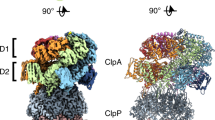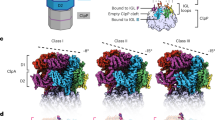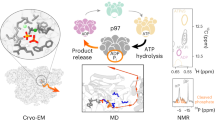Abstract
Protein cleavage inside the cell membrane triggers various pathophysiological signaling pathways, but the mechanism of catalysis is poorly understood. We solved ten structures of the Escherichia coli rhomboid protease in a bicelle membrane undergoing time-resolved steps that encompass the entire proteolytic reaction on a transmembrane substrate and an aldehyde inhibitor. Extensive gate opening accompanied substrate, but not inhibitor, binding, revealing that substrates and inhibitors take different paths to the active site. Catalysis unexpectedly commenced with, and was guided through subsequent catalytic steps by, motions of an extracellular loop, with local contributions from active site residues. We even captured the elusive tetrahedral intermediate that is uncleaved but covalently attached to the catalytic serine, about which the substrate was forced to bend dramatically. This unexpectedly stable intermediate indicates rhomboid catalysis uses an unprecedented reaction coordinate that may involve mechanically stressing the peptide bond, and could be selectively targeted by inhibitors.
This is a preview of subscription content, access via your institution
Access options
Access Nature and 54 other Nature Portfolio journals
Get Nature+, our best-value online-access subscription
$29.99 / 30 days
cancel any time
Subscribe to this journal
Receive 12 print issues and online access
$189.00 per year
only $15.75 per issue
Buy this article
- Purchase on Springer Link
- Instant access to full article PDF
Prices may be subject to local taxes which are calculated during checkout






Similar content being viewed by others
Data availability
Coordinates of all structures have been deposited into the Protein Data Bank under accession codes 6PJ4 (Snapshot-I1), 6PJ5 (Snapshot-I2), 6PJ7 (Snapshot-I3), 6PJ8 (Snapshot-I4), 6PJ9 (Snapshot-S1), 6PJA (Snapshot-S2), 6PJP (Snapshot-S3), 6PJQ (Snapshot-S4), 6PJR (Snapshot-S5) and 6PJU (Snapshot-S6). Source data for Fig. 5b–d are available with the paper online. Any other data are available from the authors upon reasonable request.
References
Brown, M. S., Ye, J., Rawson, R. B. & Goldstein, J. L. Regulated intramembrane proteolysis: a control mechanism conserved from bacteria to humans. Cell 100, 391–398 (2000).
Urban, S. SnapShot: cartography of intramembrane proteolysis. Cell 167, 1898–1898.e1 (2016).
Verhelst, S. H. L. Intramembrane proteases as drug targets. FEBS J. 284, 1489–1502 (2017).
Dusterhoft, S., Kunzel, U. & Freeman, M. Rhomboid proteases in human disease: mechanisms and future prospects. Biochim. Biophys. Acta 1864, 2200–2209 (2017).
De Strooper, B. & Chavez Gutierrez, L. Learning by failing: ideas and concepts to tackle gamma-secretases in Alzheimer’s disease and beyond. Annu Rev. Pharmacol. Toxicol. 55, 419–437 (2015).
Urban, S. Making the cut: central roles of intramembrane proteolysis in pathogenic microorganisms. Nat. Rev. Microbiol. 7, 411–423 (2009).
Rawson, R. B. et al. Complementation cloning of S2P, a gene encoding a putative metalloprotease required for intramembrane cleavage of SREBPs. Mol. Cell 1, 47–57 (1997).
De Strooper, B. et al. A presenilin-1-dependent gamma-secretase-like protease mediates release of Notch intracellular domain. Nature 398, 518–522 (1999).
Manolaridis, I. et al. Mechanism of farnesylated CAAX protein processing by the intramembrane protease Rce1. Nature 504, 301–305 (2013).
Urban, S., Lee, J. R. & Freeman, M. Drosophila rhomboid-1 defines a family of putative intramembrane serine proteases. Cell 107, 173–182 (2001).
Kinch, L. N. & Grishin, N. V. Bioinformatics perspective on rhomboid intramembrane protease evolution and function. Biochim. Biophys. Acta 1828, 2937–2943 (2013).
Stevenson, L. G. et al. Rhomboid protease AarA mediates quorum-sensing in Providencia stuartii by activating TatA of the twin-arginine translocase. Proc. Natl Acad. Sci. USA 104, 1003–1008 (2007).
Baker, R. P., Wijetilaka, R. & Urban, S. Two plasmodium rhomboid proteases preferentially cleave different adhesins implicated in all invasive stages of malaria. PLoS Pathog. 2, e113 (2006).
O’Donnell, R. A. et al. Intramembrane proteolysis mediates shedding of a key adhesin during erythrocyte invasion by the malaria parasite. J. Cell Biol. 174, 1023–1033 (2006).
Riestra, A. M. et al. A Trichomonas vaginalis rhomboid protease and its substrate modulate parasite attachment and cytolysis of host cells. PLoS Pathog. 11, e1005294 (2015).
Lastun, V. L., Grieve, A. G. & Freeman, M. Substrates and physiological functions of secretase rhomboid proteases. Semin. Cell Dev. Biol. 60, 10–18 (2016).
Spinazzi, M. & De Strooper, B. PARL: the mitochondrial rhomboid protease. Semin. Cell Dev. Biol. 60, 19–28 (2016).
Hedstrom, L. Serine protease mechanism and specificity. Chem. Rev. 102, 4501–4524 (2002).
Samara, N. L., Gao, Y., Wu, J. & Yang, W. Detection of reaction intermediates in Mg2+-dependent DNA synthesis and RNA degradation by time-resolved X-ray crystallography. Methods Enzymol. 592, 283–327 (2017).
Radisky, E. S., Lee, J. M., Lu, C. J. & Koshland, D. E. Jr Insights into the serine protease mechanism from atomic resolution structures of trypsin reaction intermediates. Proc. Natl Acad. Sci. USA 103, 6835–6840 (2006).
Liu, B., Schofield, C. J. & Wilmouth, R. C. Structural analyses on intermediates in serine protease catalysis. J. Biol. Chem. 281, 24024–24035 (2006).
Wilmouth, R. C. et al. X-ray snapshots of serine protease catalysis reveal a tetrahedral intermediate. Nat. Struct. Biol. 8, 689–694 (2001).
Raper, A. T., Reed, A. J. & Suo, Z. Kinetic mechanism of DNA polymerases: contributions of conformational dynamics and a third divalent metal ion. Chem. Rev. 118, 6000–6025 (2018).
Morgan, J. L. et al. Observing cellulose biosynthesis and membrane translocation in crystallo. Nature 531, 329–334 (2016).
Nango, E. et al. A three-dimensional movie of structural changes in bacteriorhodopsin. Science 354, 1552–1557 (2016).
Kupitz, C. et al. Serial time-resolved crystallography of photosystem II using a femtosecond X-ray laser. Nature 513, 261–265 (2014).
Suga, M. et al. Light-induced structural changes and the site of O=O bond formation in PSII caught by XFEL. Nature 543, 131–135 (2017).
Sun, L., Li, X. & Shi, Y. Structural biology of intramembrane proteases: mechanistic insights from rhomboid and S2P to gamma-secretase. Curr. Opin. Struct. Biol. 37, 97–107 (2016).
Strisovsky, K., Sharpe, H. J. & Freeman, M. Sequence-specific intramembrane proteolysis: identification of a recognition motif in rhomboid substrates. Mol. Cell 36, 1048–1059 (2009).
Urban, S. & Freeman, M. Substrate specificity of rhomboid intramembrane proteases is governed by helix-breaking residues in the substrate transmembrane domain. Mol. Cell 11, 1425–1434 (2003).
Cho, S., Dickey, S. W. & Urban, S. Crystal structures and inhibition kinetics reveal a two-stage catalytic mechanism with drug design implications for rhomboid proteolysis. Mol. Cell 61, 329–340 (2016).
Zoll, S. et al. Substrate binding and specificity of rhomboid intramembrane protease revealed by substrate-peptide complex structures. EMBO J. 33, 2408–2421 (2014).
Dickey, S. W., Baker, R. P., Cho, S. & Urban, S. Proteolysis inside the membrane is a rate-governed reaction not driven by substrate affinity. Cell 155, 1270–1281 (2013).
Ticha, A. et al. Sensitive versatile fluorogenic transmembrane peptide substrates for rhomboid intramembrane proteases. J. Biol. Chem. 292, 2703–2713 (2017).
Moin, S. M. & Urban, S. Membrane immersion allows rhomboid proteases to achieve specificity by reading transmembrane segment dynamics. eLife 1, e00173 (2012).
Urban, S. & Moin, S. M. A subset of membrane-altering agents and gamma-secretase modulators provoke nonsubstrate cleavage by rhomboid proteases. Cell Rep. 8, 1241–1247 (2014).
Urban, S. & Wolfe, M. S. Reconstitution of intramembrane proteolysis in vitro reveals that pure rhomboid is sufficient for catalysis and specificity. Proc. Natl Acad. Sci. USA 102, 1883–1888 (2005).
Zhou, Y. & Zhang, Y. Serine protease acylation proceeds with a subtle re-orientation of the histidine ring at the tetrahedral intermediate. Chem. Commun. (Camb.) 47, 1577–1579 (2011).
Schechter, I. Mapping of the active site of proteases in the 1960s and rational design of inhibitors/drugs in the 1990s. Curr. Protein Pept. Sci. 6, 501–512 (2005).
Baker, R. P. & Urban, S. Architectural and thermodynamic principles underlying intramembrane protease function. Nat. Chem. Biol. 8, 759–768 (2012).
Baker, R. P., Young, K., Feng, L., Shi, Y. & Urban, S. Enzymatic analysis of a rhomboid intramembrane protease implicates transmembrane helix 5 as the lateral substrate gate. Proc. Natl Acad. Sci. USA 104, 8257–8262 (2007).
Xue, Y. & Ha, Y. Catalytic mechanism of rhomboid protease GlpG probed by 3,4-dichloroisocoumarin and diisopropyl fluorophosphonate. J. Biol. Chem. 287, 3099–3107 (2012).
Xue, Y. et al. Conformational change in rhomboid protease GlpG induced by inhibitor binding to its S′ subsites. Biochemistry 51, 3723–3731 (2012).
Paslawski, W. et al. Cooperative folding of a polytopic alpha-helical membrane protein involves a compact N-terminal nucleus and nonnative loops. Proc. Natl Acad. Sci. USA 112, 7978–7983 (2015).
Xue, Y. & Ha, Y. Large lateral movement of transmembrane helix S5 is not required for substrate access to the active site of rhomboid intramembrane protease. J. Biol. Chem. 288, 16645–16654 (2013).
Baker, R. P. & Urban, S. Cytosolic extensions directly regulate a rhomboid protease by modulating substrate gating. Nature 523, 101–105 (2015).
Wang, Y. & Ha, Y. Open-cap conformation of intramembrane protease GlpG. Proc. Natl Acad. Sci. USA 104, 2098–2102 (2007).
Urban, S. & Baker, R. P. In vivo analysis reveals substrate-gating mutants of a rhomboid intramembrane protease display increased activity in living cells. Biol. Chem. 389, 1107–1115 (2008).
Drag, M. & Salvesen, G. S. Emerging principles in protease-based drug discovery. Nat. Rev. Drug Discov. 9, 690–701 (2010).
Kamp, F. et al. Intramembrane proteolysis of β-amyloid precursor protein by γ-secretase is an unusually slow process. Biophys. J. 108, 1229–1237 (2015).
Szaruga, M. et al. Alzheimer’s-causing mutations shift αβ length by destabilizing gamma-secretase-abetan interactions. Cell 170, 443–456 e14 (2017).
Bolduc, D. M., Montagna, D. R., Gu, Y., Selkoe, D. J. & Wolfe, M. S. Nicastrin functions to sterically hinder γ-secretase-substrate interactions driven by substrate transmembrane domain. Proc. Natl Acad. Sci. USA 113, E509–E518 (2016).
Collaborative Computational Project, Number 4 The CCP4 suite: programs for protein crystallography. Acta Crystallogr. D 50, 760–763 (1994).
Emsley, P. & Cowtan, K. Coot: model-building tools for molecular graphics. Acta Crystallogr. D 60, 2126–2132 (2004).
Baker, R. P. & Urban, S. An inducible reconstitution system for the real-time kinetic analysis of protease activity and inhibition inside the membrane. Methods Enzymol. 584, 229–253 (2017).
Kreutzberger, A. J. B., Ji, M., Aaron, J., Mihaljevic, L. & Urban, S. Rhomboid distorts lipids to break the viscosity-imposed speed limit of membrane diffusion. Science 363, eaao0076 (2019).
Acknowledgements
We are grateful to current and past members of the Urban laboratory for discussions and support, as well as the expert, friendly and helpful staff at the Cornell High Energy Synchrotron Source (CHESS) for access to beam time. This work was supported by a National Institutes of Health grant (no. R01AI066025 to S.U.). All X-ray diffraction data were collected using instruments at CHESS (beamline supported by National Science Foundation grant no. DMR-0936384 and National Institutes of Health grant no. GM-103485).
Author information
Authors and Affiliations
Contributions
S.U. and S.C. conceived the research. S.U. made all DNA constructs. S.C. performed protein purification, X-ray crystallography and structure determination. R.P.B. performed protein purification, enzyme kinetics and thermostability analyses. M.J. conducted EPR spectroscopy. S.U. wrote the paper and all authors approved the final version of the manuscript.
Corresponding author
Ethics declarations
Competing interests
The authors declare no competing interests.
Additional information
Peer review information Ines Chen was the primary editor on this article and managed its editorial process and peer review in collaboration with the rest of the editorial team.
Publisher’s note Springer Nature remains neutral with regard to jurisdictional claims in published maps and institutional affiliations.
Integrated supplementary information
Supplementary Figure 1 Time-resolved X-ray crystallographic analysis of aldehyde inhibitor binding and catalysis.
A simplified schematic of GlpG action on a peptide aldehyde (see primary Fig. 3 for stereoimages and electron densities). Waters appear as red spheres, while the L5 loop is colored in pink throughout for emphasis. To obtain these structural snapshots, crystals of GlpG in a bicelle membrane were soaked with the Ac-VRMA-CHO peptide aldehyde for increasing lengths of time prior to freezing and X-ray diffraction analysis. In addition to the catalytic steps, the interactions that formed with the L5 loop are detailed in the lower left image (panel c), which is the same data as in panel b but includes L5 sidechain/mainchain interaction details.
Supplementary Figure 2 Time-resolved X-ray crystallographic analysis of transmembrane substrate binding and cleavage.
A simplified schematic of catalytic action by GlpG on a peptide substrate (see primary Fig. 4 for stereoimages and electron densities). To obtain these structural snapshots, crystals of GlpG in a bicelle membrane were soaked with the Ac-RKVRMAAIVFSFP-amide peptide for increasing lengths of time prior to freezing and X-ray diffraction analysis. The abrupt substrate bend is detailed in the lower left image, which is the same data as the panel above it but rotated ~90° to the right. Waters are rendered as red spheres, while disordered regions are highlighted in red (in b, e, f, h) or grey (in d) during the reaction steps.
Supplementary information
Supplementary Information
Supplementary Figs. 1 and 2.
Source data
Rights and permissions
About this article
Cite this article
Cho, S., Baker, R.P., Ji, M. et al. Ten catalytic snapshots of rhomboid intramembrane proteolysis from gate opening to peptide release. Nat Struct Mol Biol 26, 910–918 (2019). https://doi.org/10.1038/s41594-019-0296-9
Received:
Accepted:
Published:
Issue Date:
DOI: https://doi.org/10.1038/s41594-019-0296-9



